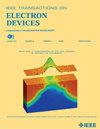Tunnel Junction-Enabled AlGaN/GaN Heterojunction Bipolar Transistors With All n-Type Contacts
IF 2.9
2区 工程技术
Q2 ENGINEERING, ELECTRICAL & ELECTRONIC
引用次数: 0
Abstract
The performance of contemporary GaN heterojunction bipolar transistors (HBTs) is currently limited by challenges associated with the formation of p-type contacts for the base terminal. In this article, we report on the design and demonstration of GaN HBTs with all n-type contacts for the emitter, base, and collector terminals. We show that degenerately doped GaN tunnel junctions (TJs) can be utilized to function as a base contact at reverse bias and as an emitter terminal at forward bias. We demonstrate device operation using a p + /n + GaN TJ sandwiched between a graded AlGaN emitter and a p-GaN base layer with an interdigitated emitter/base stripe design. The device displayed a high collector current density (采用隧道结的全 n 型触点 AlGaN/GaN 异质结双极晶体管
当代氮化镓异质结双极晶体管(HBT)的性能目前受到与基极形成 p 型触点有关的挑战的限制。在本文中,我们报告了发射极、基极和集电极全部采用 n 型触点的 GaN HBT 的设计和演示。我们展示了可利用变性掺杂的 GaN 隧道结 (TJ) 在反向偏压时作为基极触点,在正向偏压时作为发射极。我们利用夹在分级 AlGaN 发射极和 p-GaN 基底层之间的 p+/n+ GaN TJ(发射极/基极条纹交错设计)演示了器件的工作原理。从普通发射极输出({I} _{text {C}}$-{V} _{text {CE}}$)特性中提取的集电极电流密度({I} _{C}$ )高达 28 kA/cm2。这种新颖的 HBT 设计方法避免了在基底上制造 p 型触点的需要,并消除了发射极/基底外延层的再生长,从而极大地推动了当前 III 氮化物 HBT 领域在下一代射频 (RF) 和毫米波 (mm-Wave) 应用中的发展。
本文章由计算机程序翻译,如有差异,请以英文原文为准。
求助全文
约1分钟内获得全文
求助全文
来源期刊

IEEE Transactions on Electron Devices
工程技术-工程:电子与电气
CiteScore
5.80
自引率
16.10%
发文量
937
审稿时长
3.8 months
期刊介绍:
IEEE Transactions on Electron Devices publishes original and significant contributions relating to the theory, modeling, design, performance and reliability of electron and ion integrated circuit devices and interconnects, involving insulators, metals, organic materials, micro-plasmas, semiconductors, quantum-effect structures, vacuum devices, and emerging materials with applications in bioelectronics, biomedical electronics, computation, communications, displays, microelectromechanics, imaging, micro-actuators, nanoelectronics, optoelectronics, photovoltaics, power ICs and micro-sensors. Tutorial and review papers on these subjects are also published and occasional special issues appear to present a collection of papers which treat particular areas in more depth and breadth.
 求助内容:
求助内容: 应助结果提醒方式:
应助结果提醒方式:


